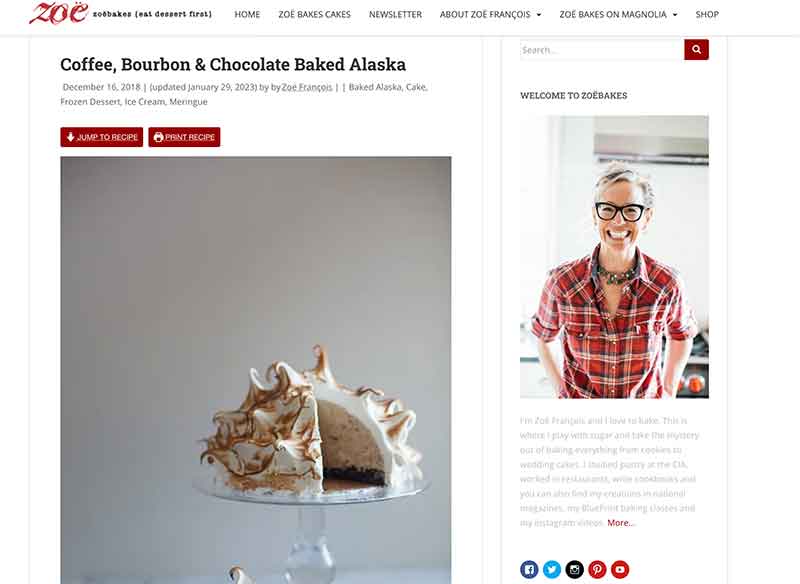A Culinary Marvel of Contrasts
Jose Mier and his Sun Valley, CA freezer are home to many different desserts but baked Alaska is one that he keeps returning to. Now, he’s found a boozy recipes on Zoebakes.com for a coffee, chocolate and bourbon version.

Baked Alaska, often hailed as a showstopper among desserts, stands as a testament to the marriage of diverse textures and temperatures. This culinary delight, with its combination of warm and cold elements, has a rich history and a place of prominence in the world of desserts. From its disputed origins to its enduring popularity, Baked Alaska has become a symbol of innovation and artistry in the culinary realm.
The genesis of Baked Alaska is a topic of debate among culinary historians, but many attribute its creation to the mid-19th century. One popular narrative suggests that it was first conceptualized at Delmonico’s, a renowned restaurant in New York City, during the 1860s. At the time, the United States had recently acquired Alaska from Russia, and in a patriotic and inventive gesture, the chef named the dessert in honor of the newly acquired territory. While this tale adds a touch of romanticism to Baked Alaska’s origin story, others argue that variations of similar desserts were present in European culinary traditions before this period.
The core concept of Baked Alaska revolves around the combination of cake, ice cream, and meringue. The dessert typically begins with a base layer of sponge cake or genoise, providing a stable foundation for the layers that follow. The cake is then topped with a generous layer of ice cream, often chosen for its complementary flavors and textures. Traditional variations might include vanilla or chocolate, but contemporary interpretations explore a myriad of ice cream flavors, adding a layer of creativity to the dessert.
What truly elevates Baked Alaska to a culinary marvel is the final layer – a thick coating of meringue. The meringue serves as both insulation and decoration, creating a protective shell around the ice cream that shields it from the intense heat of the oven or a kitchen torch. This outer layer not only prevents the ice cream from melting during the brief baking or torching process but also transforms into a golden and delicately crisp shell, providing a delightful contrast to the cold and creamy interior.
The magic of Baked Alaska lies in the theatrical presentation as well. The dessert is often flamboyantly served, making it a spectacular centerpiece at celebratory events. When it’s time to indulge, the Baked Alaska is typically brought to the table, and a thin layer of alcohol, such as rum or brandy, is sometimes added before the final baking or torching. This not only contributes to the flavor profile but also enhances the dramatic flair of the dessert as it is set ablaze, captivating diners with a brief, mesmerizing display.
As with any iconic dish, Baked Alaska has evolved over the years. Modern chefs and home bakers alike have experimented with various cake bases, ice cream flavors, and meringue variations. Some adventurous renditions include using brownie layers, fruit sorbets, or incorporating unexpected elements like nuts or chocolate chips into the ice cream. The creativity surrounding Baked Alaska has allowed it to transcend its historical origins and remain relevant in contemporary culinary conversations.
Beyond its role as a delicious dessert, Baked Alaska is a technical challenge for chefs. Achieving the delicate balance between a crisp meringue shell and perfectly frozen ice cream requires precision and skill. The meringue must be whipped to the right consistency, and the baking or torching process needs to be executed swiftly to avoid melting the ice cream. The result is not just a treat for the taste buds but also a testament to the chef’s craftsmanship.
While the name “Baked Alaska” has become synonymous with this particular dessert, it is worth noting that similar desserts exist in various culinary traditions. The French have their “omelette norvégienne,” a dessert with a similar concept, and the Italians boast the “cassata,” a layered dessert with cake and ice cream. Each culture puts its unique spin on the combination of hot and cold elements, showcasing the universality of the appeal of such contrasts in the culinary world.
The enduring popularity of Baked Alaska can be attributed to its ability to evoke a sense of nostalgia while simultaneously offering a canvas for culinary innovation. Many individuals associate Baked Alaska with special occasions and celebrations, where its grand appearance and delightful combination of flavors make it a fitting choice for a memorable finale. The dessert has also found its way into popular culture, making appearances in films, television shows, and culinary competitions, further solidifying its status as a cultural icon.
The evolution of Baked Alaska can also be seen in its adaptation to dietary preferences and restrictions. With the rise of plant-based diets, vegan variations of Baked Alaska have emerged, featuring dairy-free ice cream and aquafaba-based meringue. These adaptations allow a wider audience to enjoy the indulgence of Baked Alaska while accommodating diverse dietary needs.
In conclusion, Baked Alaska stands as a culinary marvel that has transcended its disputed origins to become a symbol of creativity and celebration. Its combination of warm and cold elements, along with its visually stunning presentation, has made it a timeless and beloved dessert. Whether rooted in history or embracing contemporary twists, Baked Alaska continues to capture the imagination of both chefs and diners, ensuring its place as a cherished classic in the ever-evolving world of desserts.